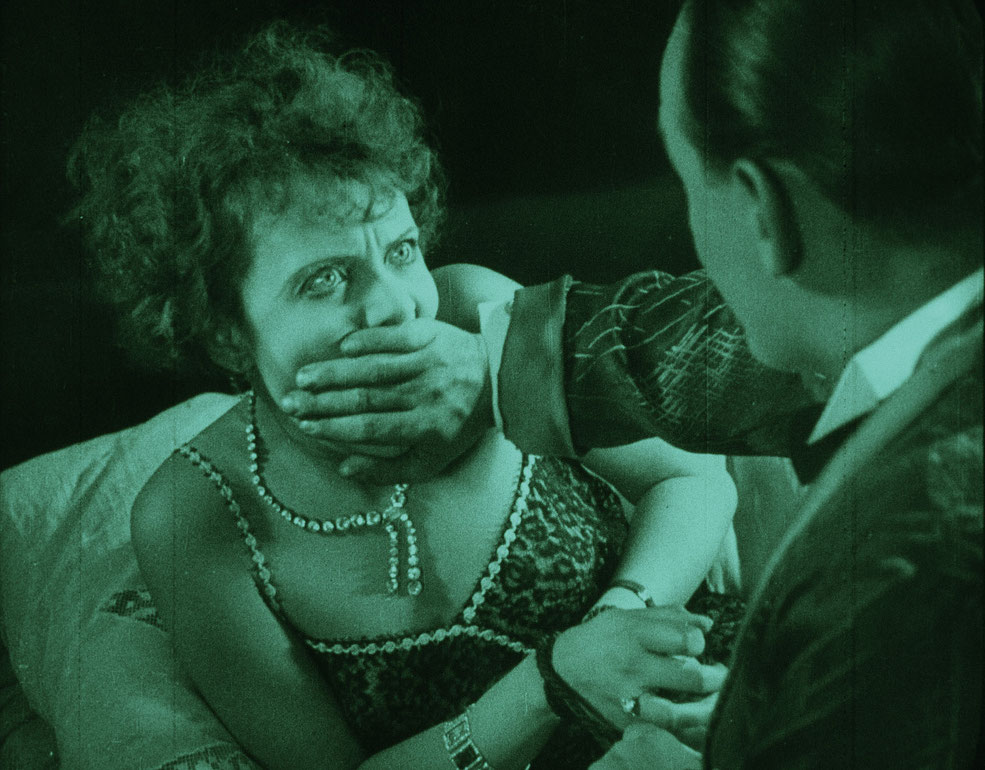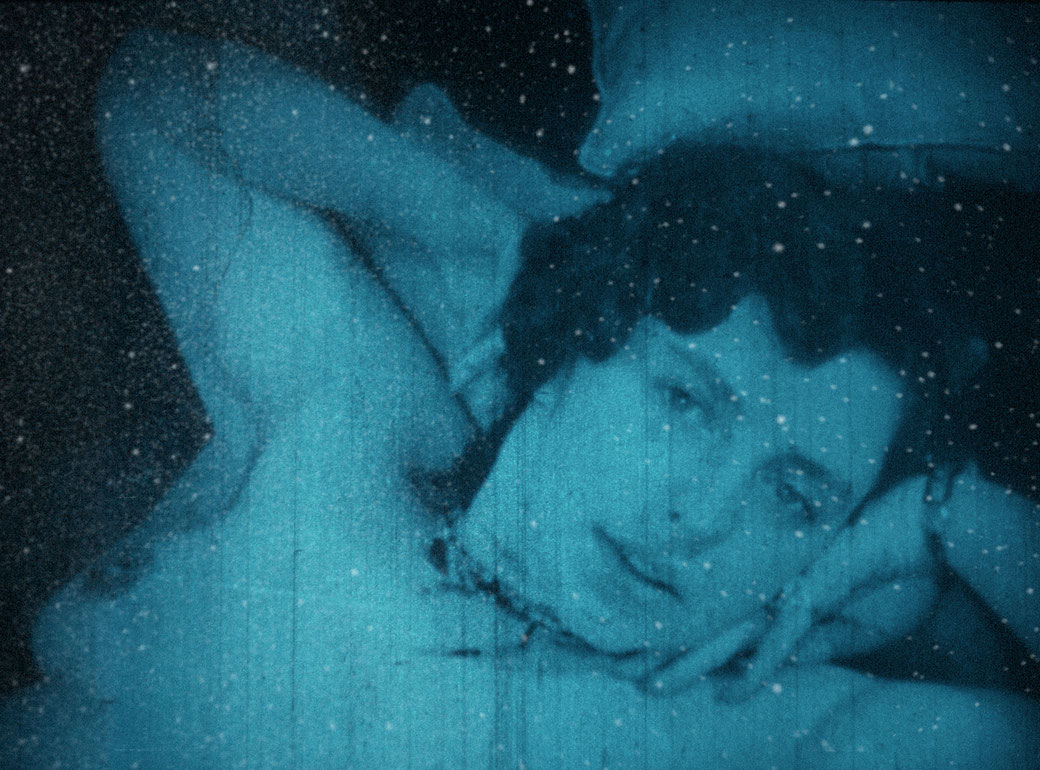FILM IST. a girl & a gun
Once upon a time cinema was born of the spirit of fairground attractions, sleight of hand and fireworks (genesis). The world of moving images, glowing deep red (paradeisos), was soon populated by all kinds of rejoicing figures, who jumped, crawled and rolled in groups through forests and over dunes. Later man opened his wall safe to woman with the code word eros; a little finger was kissed tenderly, a violent grab was met with his hand being bitten. The age of masquerades, games of hide and seek, and playacting had begun. The hands of strange men loaded and bent female bodies. Phallic objects injected desire and death (thanatos). After the birth of the (imaginary) round man the preference shifted to seeing bodies in pairs (symposium).
"To be continued" comes at the end. Using images "from the first four and a half decades of cinematography," taken from 11 archives across the world, Gustav Deutsch has constructed a musical "film drama in five acts." In detail, the editing of FILM IST. is again based on visual analogies, the external similarity of bodies, objects, movements and narratives. The film constructs its own amazing attractions from the juxtaposition of documentary, fictional, pornographic, scientific and propaganda images that are literally alien to their original purpose. In other words, they are images that do not necessarily belong together, though they create visual contexts.
The central thread is supplied by ancient mythology, fragmentary quotes of Hesiod, Sappho and Plato. And a line leads from the ancients to the mythical stories that cinema is still telling. Film is: a girl and a gun.
(Isabella Reicher)
Translation: Steve Wilder
FILM IST. a girl & a gun is a film drama in five acts that deals with one of the oldest themes of cinematography and humankind: the confrontation of the sexes. From the birth of the universe and the world through the collaboration of and confrontation between the gods and goddesses of creation; through the innocent coexistence of men and woman in Paradise; through the desire, seduction, love, jealousy and hate of the sexes in light of eros; to the escalation of their violent subjugation and exploitation in war and pornography in the mirror of thanatos; and to the solutions offered by knowledge, religion and politics in the dialogue of symposium: filmic images from the first four and a half decades of cinematography have been found through painstaking research and assembled into sequences and visual histories with new meanings.
(Gustav Deutsch)
In Old Clips, a Paradise Found and Lost (Critique)
If the narrative that Mr. Deutsch has created is rather less thrilling than his mostly silent and often glorious images, this is nonetheless a story well worth considering, and watching. Using material gathered from the likes of the Imperial War Museum (in Britain) and the Kinsey Institute for Research in Sex, Gender and Reproduction (at Indiana University), he has fashioned something of an origin story about cinema itself. Its a tale that begins with an unidentified image of a woman in buckskin shooting at some targets and ends with a cowboy bandit pointing his gun at the camera, an image appropriated from Edwin S. Porters 1903 short, The Great Train Robbery, one of the most famous in cinema history. Tucked between these loaded images, as it were, is a vision of cinematic paradise, found and lost.
Tumult of a kind pursues the shooting woman (nothing new there) in the form of a mesmerizing, mysterious shot of what looks like an archery target in flames and some text (at the first Chaos came to be) from Theogony, an epic Greek poem by Hesiod about the origin of the world. The archery target gives way to fiery orange images of billowing smoke and some electronic thrumming. (The intermittent score tends to underscore the obvious.) The thrumming turns to droning, the smoke turns to lava, followed by more Hesiod (wide-bosomed earth), a woman with bountiful breasts, Paradeisos (Greek for paradise) and naked beachfront frolickers.
It is, as you might guess, all downhill from there, at least on one level. Cinematically, however, there are more delights to come. In addition to being an estimable archaeologist of the cinema, to borrow a nice description from the Austrian critic Stefan Grissemann, Mr. Deutsch is a crackerjack editor. In the next section, Eros, for instance, he intercuts images of a muscleman curling and uncurling his arms with time-lapse images of blooming flowers, underlining the sensuous similarities between the different motions. But because he is constructing a story, he then slips an image of a woman into the mix, which adds a suggestion of drama (whats she doing here?) to what had been an elegant visual comparison between man and flower.
Women turn out to be the fly in the ointment in a Girl & a Gun. (Dead flies cause the ointment of the apothecary to send forth a stinking savor or so it says in Ecclesiastes.) Among the many images that follow, many beautifully and floridly tinted, are sleeping, dreaming and fornicating clothed and unclothed women. In one early section, a woman drowsing in a steam room seems to dream of both an undulating jellyfish and a swimming man. In another section, a woman watches a man spin four strange dials hidden behind a cabinet, as if he were initiating her into a secret world. (On the soundtrack, you hear she dies.) A world, a subsequent shot suggests of a woman reading a newspaper with the headline Cine Monde that has been made from images.
A Girl & a Gun Film Ist is German for Film Is is the third in Mr. Deutschs evolving series that began with Film Ist. (1-6), which was created largely from scientific images, and continued with Film Ist. (7-12), stitched together from early cinema gags and tricks. (These will be shown at Anthology Film Archives in New York, in conjunction with the theatrical run of a Girl & a Gun.) Part of the pleasure of the first sections is their relative straightforwardness, particularly 1-6, which, through artfully edited visual splendors a talking skeleton, a walking cat, a spinning record creates a graceful meditation on cinema as motion, as material, as perfection. With a Girl & a Gun, Mr. Deutsch brings in Eros and Thanatos to a seductive if familiar end.
By MANOHLA DARGIS
Published: December 2, 2009, New York Times
Melissa Anderson / VILLAGE VOICE NY (Critique)
Melissa Anderson / VILLAGE VOICE NY about FILM IS. a girl & a gun by Gustav Deutsch
FILM IST. a girl & a gun
2009
Austria
93 min




